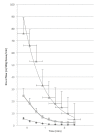Resting blood flow in the skin: does it exist, and what is the influence of temperature, aging, and diabetes?
- PMID: 22768900
- PMCID: PMC3440047
- DOI: 10.1177/193229681200600324
Resting blood flow in the skin: does it exist, and what is the influence of temperature, aging, and diabetes?
Abstract
Measurement of resting blood flow to the skin and other organs is an important indicator of health and disease and a way to assess the reaction to various stimuli and pharmaceutical interventions. However, unlike plasma ions such as sodium or potassium, it is difficult to determine what the proper value for resting blood flow really is. Part of the problem is in the measurement of blood flow; various techniques yield very different measures of skin blood flow even in the same area. Even if there were common techniques, resting blood flow to tissue, such as the skin, is determined by the interaction of a plurality of factors, including the sympathetic nervous system, temperature, pressure, shear forces on blood vessels, tissue osmolality, and a variety of other stimuli. Compounding this variability, the blood flow response to any stressor is reduced by free radicals in the blood and diminished by aging and diabetes. Race also has an effect on resting blood flow to the skin. All these factors interact to make the exact resting blood flow difficult to determine in any one individual and at any one time. This review examines the main techniques to assess blood flow, the factors that alter blood flow in the skin, and how aging and diabetes affect blood flow. Recommendations for the measurement of resting blood flow are presented.
© 2012 Diabetes Technology Society.
Figures











Similar articles
-
The influence of environmental temperature on the response of the skin to local pressure: the impact of aging and diabetes.Diabetes Technol Ther. 2009 Dec;11(12):791-8. doi: 10.1089/dia.2009.0097. Diabetes Technol Ther. 2009. PMID: 20001680
-
Galvanic skin resistance--a marker for endothelial damage in diabetes.Diabetes Technol Ther. 2009 Jul;11(7):461-7. doi: 10.1089/dia.2008.0096. Diabetes Technol Ther. 2009. PMID: 19580361
-
Multiple stressors and the response of vascular endothelial cells: the effect of aging and diabetes.Diabetes Technol Ther. 2009 Feb;11(2):73-9. doi: 10.1089/dia.2008.0026. Diabetes Technol Ther. 2009. PMID: 19848572
-
Peripheral mechanisms of thermoregulatory control of skin blood flow in aged humans.J Appl Physiol (1985). 2010 Nov;109(5):1538-44. doi: 10.1152/japplphysiol.00338.2010. Epub 2010 Apr 22. J Appl Physiol (1985). 2010. PMID: 20413421 Free PMC article. Review.
-
Thermal provocation to evaluate microvascular reactivity in human skin.J Appl Physiol (1985). 2010 Oct;109(4):1239-46. doi: 10.1152/japplphysiol.00414.2010. Epub 2010 May 27. J Appl Physiol (1985). 2010. PMID: 20507974 Free PMC article. Review.
Cited by
-
In vivo skin thermophysical property testing technology using flexible thermosensor-based 3ω method.Int J Heat Mass Transf. 2020 Dec;163:120550. doi: 10.1016/j.ijheatmasstransfer.2020.120550. Epub 2020 Oct 9. Int J Heat Mass Transf. 2020. PMID: 33071298 Free PMC article.
-
Epidermal devices for noninvasive, precise, and continuous mapping of macrovascular and microvascular blood flow.Sci Adv. 2015 Oct 30;1(9):e1500701. doi: 10.1126/sciadv.1500701. eCollection 2015 Oct. Sci Adv. 2015. PMID: 26601309 Free PMC article.
-
High Precision Human Skin Temperature Fluctuations Measuring Instrument.Sensors (Basel). 2021 Jun 15;21(12):4101. doi: 10.3390/s21124101. Sensors (Basel). 2021. PMID: 34203648 Free PMC article.
-
Mechanically and physiologically optimizing prosthetic elevated vacuum systems in people with transtibial amputation: a pilot study.J Prosthet Orthot. 2022 Oct;34(4):194-201. doi: 10.1097/jpo.0000000000000396. Epub 2021 Oct 28. J Prosthet Orthot. 2022. PMID: 36582938 Free PMC article.
-
Continuous monitoring of deep-tissue haemodynamics with stretchable ultrasonic phased arrays.Nat Biomed Eng. 2021 Jul;5(7):749-758. doi: 10.1038/s41551-021-00763-4. Epub 2021 Jul 16. Nat Biomed Eng. 2021. PMID: 34272524
References
-
- Petrofsky J, Berk L, Alshammari F, Lee H, Hamdan A, Yim JE, Patel D, Kodawala Y, Shetye G, Chen WT, Moniz H, Pathak K, Somanaboina K, Desai R, Dave B, Malthane S, Alshaharani M, Neupane S, Shenoy S, Nevgi B, Cho S, Al-Nakhli H. The effect of moist air on skin blood flow and temperature in subjects with and without diabetes. Diabetes Technol Ther. 2012;14(2):105–116. - PubMed
-
- Petrofsky J, Alshahmmari F, Yim JE, Hamdan A, Lee H, Neupane S, Shetye G, Moniz H, Chen WT, Cho S, Pathak K, Malthane S, Shenoy S, Somanaboina K, Alshaharani M, Nevgi B, Dave B, Desai R. The interrealtionship between locally applied heat, ageing and skin blood flow on heat transfer into and from the skin. J Med Eng Technol. 2011;35(5):262–274. - PubMed
-
- Petrofsky J, Paluso D, Anderson D, Swan K, Yim JE, Murugesan V, Chindam T, Goraksh N, Alshammari F, Lee H, Trivedi M, Hudlikar AN, Katrak V. The contribution of skin blood flow in warming the skin after the application of local heat; the duality of the Pennes heat equation. Med Eng Phys. 2011;33(3):325–329. - PubMed
-
- Seet RC, Lee CY, Loke WM, Huang SH, Huang H, Looi WF, Chew ES, Quek AM, Lim EC, Halliwell B. Biomarkers of oxidative damage in cigarette smokers: which biomarkers might reflect acute versus chronic oxidative stress? Free Radic Biol Med. 2011;50(12):1787–1793. - PubMed
-
- Whitney RJ. The measurement of changes in human limb-volume by means of a mercury-inrubber strain gauge. J Physiol. 1949;109(1-2) Proc, 5. - PubMed
Publication types
MeSH terms
LinkOut - more resources
Full Text Sources
Other Literature Sources
Medical

